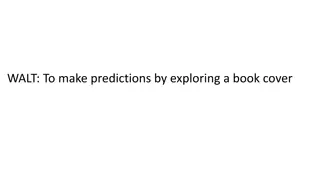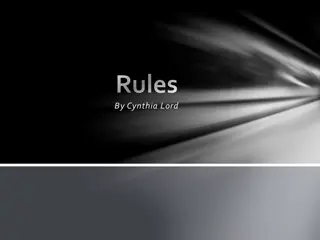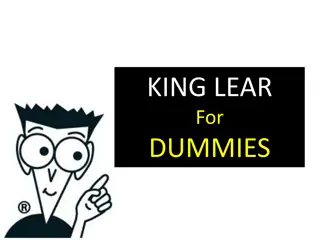Insights into "Journey's End" Characters and Plot
Explore character descriptions, key quotes, and thematic analysis of "Journey's End" characters in a revision session. Delve into the unfolding events in Acts 1 and 2, focusing on the interactions and dynamics among soldiers in a trench during World War I.
Download Presentation

Please find below an Image/Link to download the presentation.
The content on the website is provided AS IS for your information and personal use only. It may not be sold, licensed, or shared on other websites without obtaining consent from the author.If you encounter any issues during the download, it is possible that the publisher has removed the file from their server.
You are allowed to download the files provided on this website for personal or commercial use, subject to the condition that they are used lawfully. All files are the property of their respective owners.
The content on the website is provided AS IS for your information and personal use only. It may not be sold, licensed, or shared on other websites without obtaining consent from the author.
E N D
Presentation Transcript
Journeys End Revision Session Starter: Knowledge Vomit On the different tables are pieces of paper with character names: Write down everything you remember about each character. Include any quotes you can remember and also whether you think they represent any themes.
The Plot: What happens in the different Acts? On your tables construct a summary of the play. In other words write down everything you can remember about the play and the order of events. There is a sheet with some prompt reminders of some of the main parts of the plot to help you but you should
Plot Summaries Act 1: Act 1: It is the evening of Monday 18thMarch. The play opens in a dugout. Stanhope s company is about to take over from another one. They will be on duty for six days, during which time a German attack is expected. Osborne arrives as Hardy, the other company s commander, is drying his socks and singing. He and Hardy share a drink. They talk about conditions, the present situation and about Stanhope, whom Hardy describes as drinking like a fish and having strained nerves. Osborne defends his commander as dutiful, brave and experienced. He has been at the front for three years. Hardy leaves without waiting to see Stanhope.
Act 1 Continued A new officer, Raleigh, arrives. It emerges that he knows and admires Stanhope from school and that Stanhope and his sister are close. Osborne tries to warn Raleigh about the changes in Stanhope. He introduces him to the routines of trench life. Mason, the soldier cook, confides in Osborne about a mistake over tinned pineapples so that Stanhope will not blame him. Stanhope appears on stage. He calls for whiskey before even seeing Raleigh and when he does see him he is stunned as though dazed. Trotter, on the other hand, welcomes Raleigh. After eating, Trotter and Raleigh go on patrol. Hibbert enters the dugout and complains of his neuralgia a sever pain in his head and face. Stanhope thinks it is just an excuse to get sent home, but Osborne is more sympathetic. The two of them discuss Raleigh and his sister. Stanhope is concerned that Raleigh will betray him in his letters and decides to censor them. Osborne tries to calm Stanhope; sensing he is tired, he suggests that he goes to bed. Both men turn in for the night.
Act 2: It is the following morning. Stanhope is on duty in the trench and the other officers are enjoying breakfast in the dugout. They talk about Stanhope, who is looking ill, and discuss his strange behaviour towards Raleigh the previous night. Trotter talks about gardening and nature, and then leaves the stage to take over from Stanhope. Raleigh and Osborne talk; it emerges that Osborne was a schoolmaster and had played rugby for Harlequins and England. We gain an impression of Raleigh s views of war before he leaves to finish a letter that he has started to write, just as Stanhope enters the dugout. Stanhope and Osborne discuss the German attack, which is expected in two days time. Stanhope is drinking whiskey and is worried about what Raleigh thinks and what he might write in his letter. He is determined to censor it. When Raleigh enters on his way to inspect the rifles and puts his letter on the table to be sent, Stanhope tells him to leave it open. After a discussion and a struggle, Raleigh is forced to give Stanhope the letter and leaves. Stanhope is too ashamed to look at it and eventually Osborne reads it. Unexpectedly, it is full of praise for Stanhope.
Act 2 Continued: That afternoon, Stanhope issues details of work to a sergeant major, which he wants carried out before the German attack. The colonel arrives and instructs Stanhope that he is to organise a raiding party for the following day. He suggests that Osborne, and (despite Stanhope s objections) Raleigh lead the party. Stanhope is to have supper with the colonel and the colonel will talk to Osborne and Raleigh the following morning. Hibbert enters the dugout, having been asleep. He complains about his neuralgia and asks to go down the line and seek medical help. Stanhope refuses and threatens to shoot him by accident if he tries to leave. Eventually Stanhope confides in Hibbert that he is too scared and encourages him to stay to help the others. Hibbert says he will try. Osborne returns to the dugout and is told of the raid by Stanhope; Trotter who is also informed of the raid, which he feels is badly timed, soon follows him. He asks what Osborne is reading. It is Alice s Adventures in Wonderland. Stanhope and Hibbert leave to relieve Raleigh, and Osborne writes a letter. Raleigh returns to the dugout and seems to be excited at the thought of going on a raid.
Act 3: It is Wednesday afternoon. The colonel has arrived with last minute instructions and words of encouragement for the raiding party. Osborne and Raleigh sit for a few minutes before the raid. They talk about home and trivial things. Osborne puts his wedding ring on the table and the two of them leave for the raid. Noises of gunfire and shells are heard off stage. Stanhope and the colonel appear on the stage with the captured German soldier who Stanhope leaves the colonel to question. He returns and rather bitterly tells the colonel that Osborne and six men have been killed. Raleigh enters and is congratulated by the colonel, but is unable to speak. Stanhope comments that Raleigh is sitting on Osborne s bed. That evening, Trotter, Hibbert and Stanhope share stories and jokes about women, having eaten together. Raleigh has not eaten with them but has remained on duty in the trench. Hibbert and Stanhope argue and Hibbert is sent to bed. Trotter is made second in command then goes to relieve Raleigh. Stanhope is angry that Raleigh did not eat with the officers. The two argue and Raleigh expresses his confusion over Stanhope s attitude to Osborne s death. Stanhope makes it clear that he uses drink to help him cope. Raleigh tries to apologise but is told to leave and they part on bad terms.
Act 3 Continued The following morning the officers wake. The sound of German shells is heard, signalling the attack. Hibbert holds back, but eventually he and Mason leave. Stanhope is told that Raleigh has been hurt, so he has him brought into the dugout where it becomes clear that although Raleigh does not know this himself, his wounds are serious. Stanhope comforts Raleigh and gives him water, but he dies. Stanhope leaves the dugout as the sounds of shelling rises. There is darkness in the dugout and the red dawn glows . The play ends as the dull rattle of machine guns is heard: we may assume that the whole company have met their deaths.
Journeys End - Themes Task: Can you remember what the main themes of the play are? Discuss them and note them down. Mind map around each theme what you think it involves.
War It s easy to think that soldiers in wars are always fighting battles. When for most of the time, it s a matter of waiting. What soldiers do to pass the time under such horrendous stress is a major theme of the play. Sherriff wanted his audiences to understand just how this tense prolonged waiting was an untold horror of war and this helps the play create a subtle anti-war message although this was not necessarily intentional. How Sherriff manages to create a tense plot whilst also showing the boredom and waiting of trench life is one of his skills.
Although Sheriff did not write Journey s End as an anti war play the fact that the characters are seen suffering emotionally, and are presented as physically wrecked and dying, is a reminder to audiences of the casualties of war. War 1. In what ways does RC Sheriff recreate for his audience the tremendous stress and fear suffered by the men at the front? When the play was first staged the audience would have recognised Raleigh s youthful enthusiasm and Stanhope s hardened cynicism. 2. Do all the characters in this play react in the same way to the horrors of war? Many young, talented and educated men died in the First World War. They came to be known as the lost generation and it is to them that Journey s End pays homage.
Heroism The idea of heroism is explored through: Raleigh s boyish patriotic myth of the 'hero' as some kind of knight in shining armour, and the way he hero-worships Stanhope Stanhope s real fear is that his status back home as a 'hero' will be blown. This is shown in the desperate way he clutches Raleigh s wrist and tears the letter from his hand - a letter which could reveal the truth about his drinking Sheriff presents us with two sides of the coin the heroism and the cost. It is only after his experience of the raid that Raleigh begins to recognize the true price of glory. He has been exposed to the truth and the futility of the attack. Stanhope holds great fury towards Hibbert as he sees him as dishonorable and a coward. Osborne s death and the others may be seen as pointless but it is likely that Sheriff intended to pay tribute to the heroism of the men at C Company. To him they represent all the men that died in the war.
Heroism 1. What do you think were Raleigh s expectations when came to join Stanhope s company? 2. To what extent were these hopes fulfilled and how much was he disappointed?
Courage and Cowardice: Courage and Cowardice: the men coped with the war in a number of different ways Sherriff helps us to see how humans can gain courage from others as well as by diverting their thoughts through displacement strategies : Humour for example is used; Osborne is seen to be reading Alice in Wonderland a childhood book reassuring and comforting perhaps in times of great difficulty; Complaining about the food like Private Mason Smells like liver, sir, but it 'asn t got that smooth, wet look that liver s got Osborne gives advice to Raleigh: you must always think of it as romantic. It helps . Stanhope depends on drinking alcohol for courage Hibbert shows us what focusing on death can do to the nerves and health, it is never made clear if Hibbert is just a coward or has a real mental illness
Comradeship Stanhope s encouragement of Hibbert helps to suggest to the audience the importance of getting on together . Shall we go on together? We know how we both feel now. Shall we see if we can stick it together? . Even the idea of enemy is brought into question as Raleigh reminds us that Germans are just ordinary people. The use of formal surnames, Stanhope and Raleigh , for example, normal in public schools and the army is something the audience is forced to think about at the end of the play. When Raleigh is dying, he calls Stanhope Dennis who replies, to the audience s surprise with Jimmy . How men survive as a community of individuals under the most extreme stresses imaginable is at the heart of the play.
Comradeship 1. Do you think that the comradeship engendered by the war is more than mere friendship? Is it a special bond imposed by the constant threat of death? 2. What examples can you find in the play of comradeship and compassion for others?
Social Class When Sherriff was writing, the social order would have been very different to nowadays. By juxtaposing the public school educated upper class officers with working class soldiers like Trotter and Mason, Sherriff wanted to show how war brought everyone together. Stanhope tries to dismiss Trotter as having no proper feelings, but Trotter responds "Always the same, am I? (He sighs) Little you know" ; and his braveness later on in the play suggests that he is as much a 'hero' as any of the officers in the company.
How to write an exam answer On your tables, mind map everything that you would include in this kind of question. Consider: How is he presented? What methods does the writer use to show him? What themes does he represent? Sample Question: Explore the presentation of Raleigh in Journey s End.
Step 1: analyse the character He is na ve, romantic, young and inexperienced consider how this is made clear through his actions, stage directions and speech Step 2: Consider how Sheriff shows that he is important? We meet him early in the play and his death is one of the last and most significant scenes. Step 3: Think about the function that he plays in the play a) He commentates on Stanhope and gives greater insight into Osborne and Stanhope through their extended dialogues b) He adds to the sense of tragedy through his death and shows the futility of war c) He shows the themes of heroism and the ideas of a lost youth d) He offers a contrast to Hibbert and his supposed cowardice e) He almost becomes a man by the end of the play. Sample Essay Plan: The question asks you to consider two things: What Raleigh is like and How we find this out? You should also consider the hidden ideas of What makes him important? This is a good method for most character questions. Step 4: Conclude What is the lasting impression of Raleigh
Do this now as if the question was Osborne What Osborne is like and How we find this out? What makes him important? Step 1: analyse the character Step 2: Consider how Sheriff shows that he is important? Step 3: Think about the function that he plays in the play Step 4: Conclude What is the lasting impression of Osborne























